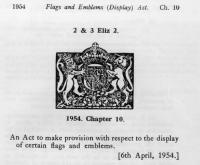| |
Flags and Emblems (Display)
Act (Northern Ireland), 1954;
[1954. Ch. 10.]
ARRANGEMENT OF SECTIONS. |
| |
Section. |
| |
1. Display of Union flag. |
| |
2. Removal of provocative emblems. |
| |
3. Penalties. |
| |
4. Restriction on prosecutions. |
| |
5. Short title. |
| |
|
| |
1954. Chapter 10. |
| |
An Act to make provision with respect to the display of certain flags and emblems.
[6th April, 1954.] |
| |
BE it enacted by the Queen’s most Excellent Majesty, and the Senate and the House of Commons of Northern Ireland in this present Parliament assembled, and by the authority of the same, as follows :- |
| Display of Union flag. |
1. Any person who prevents or threatens to interfere by force with the display of a Union flag (usually known as the Union Jack) by another person on or in any lands or premises lawfully occupied by that other person shall be guilty of an offence against this Act. |
| Removal of provocative emblems. |
2. - (l) Where any police officer, having regard to the time or place at which and the circumstances in which any emblem is being displayed, apprehends that the display of such emblem may occasion a breach of the peace, he may require the person displaying or responsible for the display of such emblem to discontinue such display or cause it to be discontinued; and any person who refuses or fails to comply with such a requirement shall be guilty of an offence against this Act. |
| |
(2) Where - |
| |
(a) a requirement under the preceding subsection is not complied with; or |
| |
(b) the person responsible for such display is not readily available; or |
|
(c) no person, or no person responsible for such display and capable of complying with such a requirement, is present on or in any lands or premises whereon or wherein such an emblem is being displayed; |
| |
a police officer may without warrant enter any such lands or premises, using such force as may be necessary, and may remove and seize and detain such emblem. |
| |
(3) It shall be a good defence to any proceedings (whether civil or criminal) against a police officer or constable in respect of anything done or omitted to be done for the purpose or in the course of carrying into effect the provisions of this section, to prove that anything in respect of which the proceedings have been instituted was done, or as the case may be omitted, in good faith for the purpose or in the course of carrying into effect any of those, provisions. |
|
| |
(4) In this section the expression "emblem" includes a flag of any kind other than the Union flag, and the expression "police officer" means an officer, head-constable or sergeant of the Royal Ulster Constabulary. |
|
| Penalties. |
3. - (l) Any person guilty of an offence against this Act shall be liable- |
| |
(a) on summary conviction, to a fine not exceeding fifty pounds or to imprisonment for a term not exceeding six months; |
| |
(b) on conviction on indictment, to a fine not exceeding five hundred pounds or to imprisonment for a term not exceeding five years;
or in any case to both the fine and the imprisonment hereinbefore respectively provided. |
| |
(2) A court before which a person is convicted of an offence under section two of this Act may order any emblem in respect of which he is so convicted, and which has been seized and detained under that section, to be destroyed or otherwise disposed of. |
| Restrictions on prosecutions. |
4. Where any person is charged with any offence against this Act the court may, if it thinks fit, order him to be remanded in custody or on bail, but save as afore said further proceedings on such a charge shall not be taken against him without the consent of the Attorney General for Northern Ireland. |
| Short title. |
5. This Act may be cited as the Flags and Emblems (Display) Act (Northern Ireland), 1954. |

